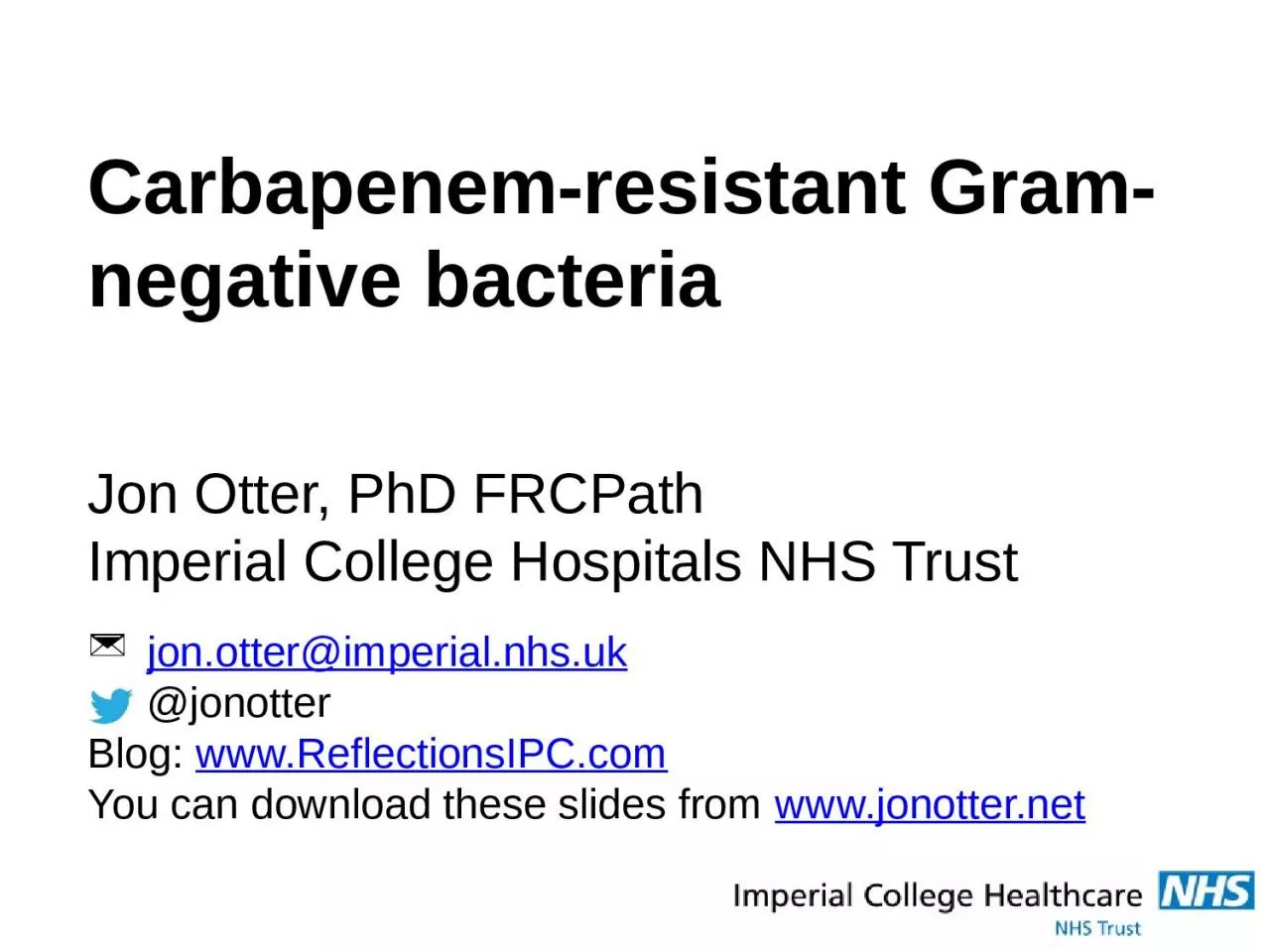

Jon Otter PhD FRCPath Imperial College Hospitals NHS Trust jonotterimperialnhsuk jonotter Blog wwwReflectionsIPCcom You can download these slides from wwwjonotternet ID: 999969
Download Presentation The PPT/PDF document "Carbapenem -resistant Gram-negative bact..." is the property of its rightful owner. Permission is granted to download and print the materials on this web site for personal, non-commercial use only, and to display it on your personal computer provided you do not modify the materials and that you retain all copyright notices contained in the materials. By downloading content from our website, you accept the terms of this agreement.
1. Carbapenem-resistant Gram-negative bacteriaJon Otter, PhD FRCPathImperial College Hospitals NHS Trust jon.otter@imperial.nhs.uk @jonotterBlog: www.ReflectionsIPC.comYou can download these slides from www.jonotter.net
2. MRSA bacteraemia, England 2001-2013Mandatory reporting, 2001‘Gettting ahead of the curve’, 2002‘Winning ways’, 2003‘Towards cleaner hospitals’, 2004‘Cleanyourhands’, 2004Targets introduced, 2004Cleanliness improvement, 2005‘Going further faster’, 2006Root cause analysis, 2006Revised national guidelines, 2006Deep clean, 2007Screening elective admissions, 2008Universal screening, 201012345678910111213
3. CDI cases, 2004-2013C. difficile infection (CDI), England 2004-2013Mandatory reporting, 2004Targets, 2007Revised guidelines, 2009123
4. THE END OF ANTIBIOTICS IS NIGH
5. “CRE are nightmare bacteria.”Dr Tom Frieden, CDC Director“If we don't take action, then we may all be back in an almost 19th Century environment where infections kill us as a result of routine operations.”Dame Sally Davies, Chief Medical Officer“If we fail to act, we are looking at an almost unthinkable scenario where antibiotics no longer work and we are cast back into the dark ages of medicine where treatable infections and injuries will kill once again.”David Cameron, Prime Minister, UK“The rise of antibiotic-resistant bacteria, however, represents a serious threat to public health and the economy.”Barack Obama, President USAWhat’s the problem?
6. Rising threat from MDR-GNR% of all HAI caused by GNRs.Hidron et al. Infect Control Hosp Epidemiol 2008;29:966-1011.Peleg & Hooper. N Engl J Med 2010;362:1804-1813.% of ICU HAI caused by GNRs.Non-fermentersAcinetobacter baumanniiPseudomonas aeruginosaStenotrophomonas maltophiliaEnterobacteriaceaeKlebsiella pneumoniaeEscherichia coliEnterobacter cloacaeCPECPO
7. ShareDifferGram stain reactionRisk factors & at-risk populationConcerning AMRPotential for epidemic spreadInfection profile & mortalityPrevalenceColonisation site & durationTransmission routesResistance profile & mechanismsEnterobacteriaceae vs. non-fermenters
8. What’s the problem? Resistance Courtesy of Pat Cattini
9. EnterobacteriaceaeNon fermentersOrganismAmpC / ESBLCREA. baumanniiAttributable mortalityModerateMassive (>50%)MinimalShorr et al. Crit Care Med 2009;37:1463-1469.Patel et al. Iinfect Control Hosp Epidemiol 2008;29:1099-1106.What’s the problem? Mortality
10. What’s the problem? Rapid spread
11.
12. Acronym minefieldMDR-GNRMDR-GNBCROCPECPECPECPCCRCCRABESBLKPC
13. What are CPE?Carbapenem-resistant Enterobacteriaceae (CRE) – Enterobacteriaceae that are resistant to carbapenems by any mechanism.Carbapenemase-producing Enterobacteriaceae (CPE) – Enterobacteriaceae that are resistant to carbapenems by means of an acquired carbapenemase.CRECPE
14. Understanding the enemyPathogenCPE1CPAB2MRSAVREC. difficileResistance+++++++++/-Resistance genesMultipleMultipleSingleSinglen/aSpeciesMultipleSingleSingleSingleSingleHA vs CAHA & CAHA (ICU)HAHAHAAt-risk ptsAllICUUnwellUnwellOldVirulence++++/-+++/-+Environment+/-+++++++++Carbapenemase-producing Enterobacteriaceae.Carbapenemase-producing Acinetobacter baumannii.
15. Clinical picture for Enterobacteriaceae vs. non-fermentersZarb et al. Euro Surveill 2012; 17(46).
16. NHSN / NNIS data; MMWR 2013;62:165-170.CRE in the USA
17. Lin et al. Clin Infect Dis 2013;57:1246-1252.CRE in LTACs, USA
18. Carbapenem-resistant organisms, EuropeEARS-Net
19. Colistin resistance in ItalyMonaco et al. 2014; Euro Surveill 2014;19:pii=20939.Survey of 191 CPE from 21 labs across Italy. 43%Colistin resistant K. pneumoniae.Range = 10-80% for the 21 labs.
20. Emergence of CPE in the UK PHE.
21. CPE in the UK and US
22. Evidence-free zone
23. Guidelines = Policy
24. Otter et al. Clin Microbiol Infect 2015 in press.
25. Who do I screen?PHE CPE Toolkit screening triggers: an inpatient in a hospital abroad, oran inpatient in a UK hospital which has problems with spread of CPE (if known), or a ‘previously’ positive case.Also consider screening admissions to high-risk units such as ICU, and patients who live overseas.
26. You have positive case: now what?‘Contact precautions’Single room+glove/gownConsider staff cohortContact tracingTrigger for screening contacts or whole unit?FlaggingPatient notes flaggedReceiving unit informedEducationStaffPatient / visitorCleaning / disinfectionUse bleach or H2O2 vapour at dischargeDecolonization?‘Selective decontamination’ / chlorhexidine bathing?
27. Can we forecast a CPE storm?What drives carbapenem resistance? The use of meropenem in the previous year plotted against the incidence rate of OXA-48-producing K. pneumoniae Could we find and implement an “alert” level of carbapenem use?The authors claim a stewardship intervention brought the CPE outbreak under control – but also implemented ‘case isolation, screening of contacts, barrier nursing and other infection control interventions’.Study focussed only on OXA-48 K. pneumoniae; what about other Enterobacteriaceae and non-fermenters.Gharbi et al. Int J Antimicrob Agents 2015 in press.
28. Decolonisation using faecal microbiota transplantation (FMT)82 year old colonised with CPE.Carriage was delaying her admission to a nursing home.Single dose of FMT decolonised her at 7 and 14 days.Laiger et al. J Hosp Infect 2015 in press.Buffie & Pamer. Nat Rev Microbiol 2013;13:790-801.
29. Cataldo et al. ECCMID 2014. 0125. Typen studiesFailure rateOdds ratioBundled intervention7528%1.9Single intervention1145%
30. What works? IsraelSchwaber et al. Clin Infect Dis 2011;52:848-855.* Physical segregation of CRE carriers; cohorted staff; appointed taskforce.*
31. CPE picture at ICHTMookerjee et al. IPS 2015.
32. KP NDM outbreak; total number of casesBrannigan et al. FIS 2015.
33. SummaryMDR-GNR are emerging worldwide and represent a unique threat.CPE in particular combine resistance, virulence and the potential for rapid spread.Prevalence appears to be patchy, but increasing.We do not yet know what is effective in terms of prevention and control, but screening and isolation of carriers seems prudent.We need to be singing from the same acronym hymnsheet!
34. Carbapenem-resistant Gram-negative bacteriaJon Otter, PhD FRCPathImperial College Hospitals NHS Trust jon.otter@imperial.nhs.uk @jonotterBlog: www.ReflectionsIPC.comYou can download these slides from www.jonotter.net